About Agua Dulce
How it all started
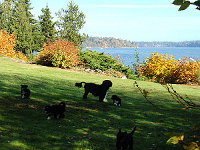
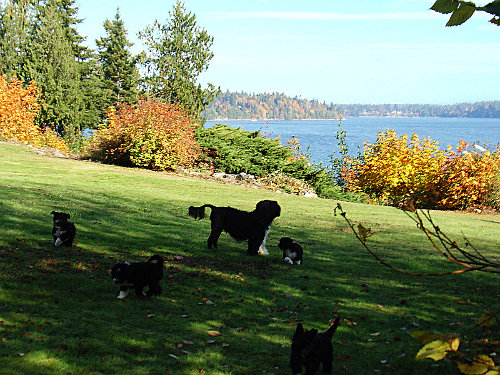 Jetty and her Pups on the lawn.
Jetty and her Pups on the lawn.
Bo'sun was our first real intoduction to PWD's. He came into are lives when we were living on our sailboat. When we moved on board we brought our aging Rottweiler Damien. Poor Damien hated the water and couldn't negotiate the steep companionway ladder, being much too heavy to lift in and out of the hatch he couldn't come into the cabin, fortunately the cockpit was fully enclosed so we put his bed there. Sadly Damien died at a little over 10 years of age. Theresa started looking for a breed more suited for life aboard a boat. Her criteria was medium size, non-shedding, no tail or tail that curled on the back, and most important, a breed that would like the water. Theresa went to the library and came back with news of the perfect breed, one that had been used on fishing boats in Portugal for centuries, the Portuguese Water Dog (PWD). We found a boy, Bo'sun in Calgary that Lana Langley had, and so began our new life with PWD's.
Is a PWD right for me?
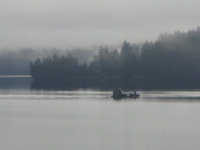
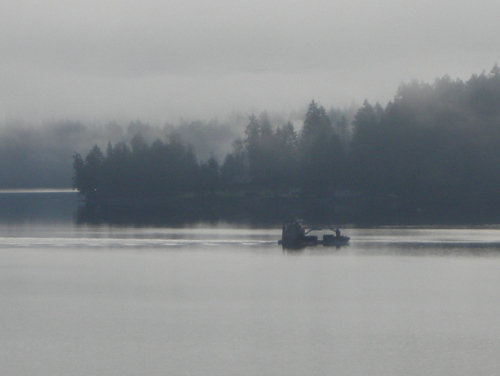 Oyster Scow in the Fog.
Oyster Scow in the Fog.
So you're thinking about a dog, maybe a PWD? Well their are some things you should know. The PWD is a working breed of medium size, a male should be somewhere between 20 to 23 inches at the withers or the top of their shoulder blades, and their weight should be between 42 and 60 pounds. A female should be somewhere around 17 to 21 inches at the withers, and their weight should be between 35 to 50 pounds. Overall a nice manageable size, about the middle range of the dog world.
Next PWD's coat, their coat is of the no shedding variety so they don't shed, but be forewarned their hair breaks off just like ours, the longer it is the more noticeable it is. They come in a curly and a wavy. People seem to have their opinions on which is easier to groom and maintain, but in my experience it doesn't matter. We had two curly dogs at the same time, Bo'sun and Filha, both had tight curls. Filha was a breeze to groom while Bo'sun was a bear. The same is true with our wavies, Jetty spends 3 hours on the table and Briny spends 1 hour, so it seems to be a bit of a crap shoot. One more thing you should know is that somewhere around 1 year old puppies blow their coat, or loose their puppy coat, about the only thing to do is shave them down or brush them 4 times a day. I like easy so unless you're showing, my vote goes to shave um down, they'll look funny but it beats fighting constant mats, besides in general all 1 year olds look funny or soon will. The bottom line is PWD's need a lot of grooming. You Like Grooming, Right? If you have a PWD grooming is in your future whether you do it yourself or pay for it, if you don't do it there is two probable outcomes the first and most likely is your PWD will mat up, get hot spots, its hair falls out, and he/she looks like a mutant Chinese Crested or the second hardly likely possibility, you brush your PWD daily, you never ever let the PWD outside, and she/he ends up looking like a cross between a yorky on steroids and cousin It. Oh Boy Grooming It Is!
More to come soon.
A Brief History Of The PWD
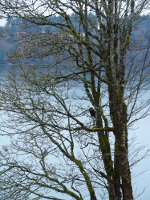
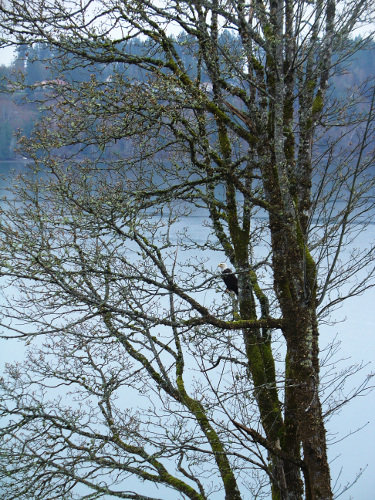 Eagle
Eagle
The Portuguese Water Dog (PWD) or Cao de agua as they are known in Portugal, which translates to "dog of the water", is thought to be an ancient breed by many. It is said the breeds origins began on the Asian steppes and that they were most likely brought to Europe by a Germanic tribe, perhaps the Visigoths or Ostrogoths or both, whatever the case they eventually came to a southern region of what is now Portugal.
As a breed their primary use was to help the fishermen at sea, but they also were used for herding. A highly intelligent breed they retrieved tackle from the water, were excellent divers, and acted as couriers between ships and from ship to shore before the advent of radios. The dogs also would jump overboard to retrieve fish that had escaped while the fishermen were bringing them aboard, and during foggy spells they were trained to stand at the bow and bark to alert other boats in the area. The intelligence and stamina of this breed made these dogs so respected by the fishermen that they received the same wages as the crew.
The modern breed can be traced to a Portuguese gentleman by the name of Vasco Bensaude and his beloved Leão in the 1930's. All current PWD lines go back to Leão whom Mr. Bensaude considered to be an ideal of the standard. Leão sired 7 litters in all. In Mr. Bensaude's latter years he began to look for someone to carry on his work with the breed. He chose Mrs. Conchita Cintron De Costello Branco.
In the mid 60's the torch was passed to Cintron when she was contacted by Vasco's widow and informed that she was to inherit all of Vasco's cherished dogs. Cintron accepted and began looking for a way to insure that the breed would prosper. She decides that the best way to achieve her goal was to introduce PWD's to America by way of correspondence and visits to the U.S. dog fancy.
In 1967 Deyanne and Herbert Miller Jr. purchased a breeding pair of PWD's from Cintron and so began the breeds climb from near extinction, due to technology replacing the dogs role on board the fishing boats, to the robust and viable breed that it is today.
For a more in depth history of the Portuguese Water Dog read Kathryn Braund's book "The New Complete Portuguese Water Dog" ISBN 0-87605-261-8.
